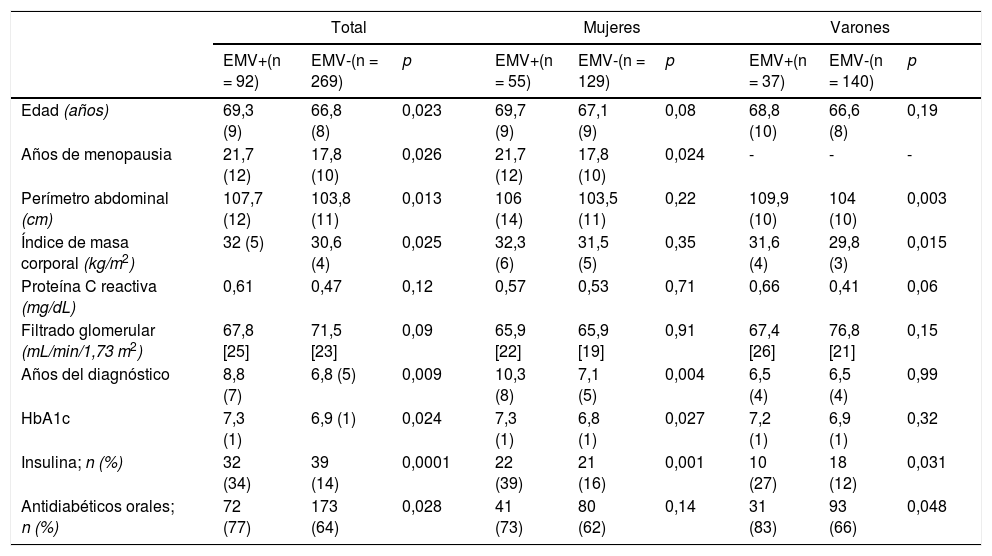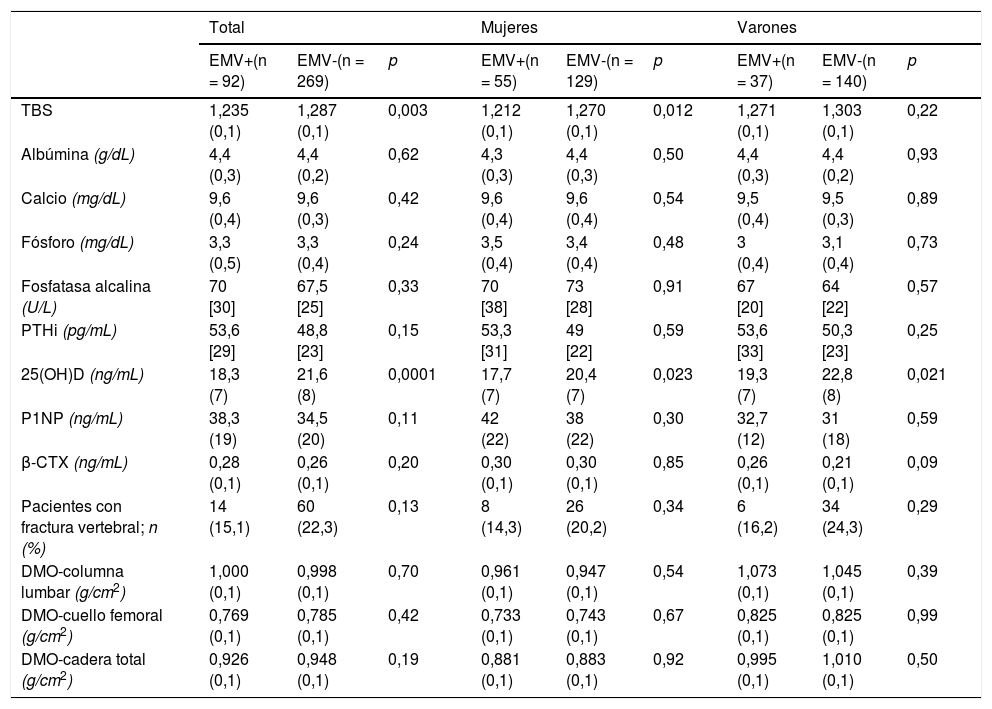La enfermedad microvascular (EMV) diabética ha sido asociada con una fragilidad ósea incrementada. El objetivo fue analizar la relación entre la EMV y la microestructura trabecular -evaluada mediante el índice trabecular óseo (trabecular bone score, TBS)- en pacientes diabéticos tipo 2 (DM2). Adicionalmente, conocer la relación entre la vitamina D y la EMV.
Pacientes y métodosDiseño transversal analítico, que incluyó varones > 50 años y mujeres postmenopáusicas con DM2, participantes en una cohorte poblacional. Se clasificó como EMV+ la presencia de nefropatía, neuropatía y/o retinopatía. Fueron analizadas variables clínicas, de laboratorio, el TBS, la 25-hidroxivitamina D [25(OH)D] y la densidad mineral ósea (DMO). Se realizaron análisis bivariable y multivariable.
ResultadosFueron evaluados 361 pacientes (51,1% mujeres), de 63,8 (9) años. De ellos, 92 tenían EMV, con un peor control metabólico, mayor duración de la DM2, menor TBS (1,235 [0,1] vs. 1,287 [0,1]; p=0,003) y menores niveles de 25(OH)D (18,3 [7] vs. 21,6 [8] ng/mL; p=0,0001). No hubo diferencias entre EMV+ y EMV- en la DMO ni en los marcadores P1NP y β-CTX. Tras ajustar por confusores, incluyendo HbA1c y duración de la DM2, el TBS en EMV+ fue 1,252 (IC 95% 1,230-1,274) vs. 1,281 (IC 95% 1,267-1,295) en EMV- (p=0,034). La EMV se asoció a un nivel de 25(OH)D < 20 ng/mL con una OR ajustada=1,88 (IC 95% 1,06-3,31; p=0,028).
ConclusionesLos pacientes con EMV presentaron un TBS significativamente menor, tras ajustar por confusores. El análisis multivariable mostró asimismo una asociación significativa entre un nivel bajo de 25(OH)D y la EMV prevalente.
Diabetic microvascular disease (MVD) has been associated with increased bone fragility. The objective was to analyse the relationship between MVD and trabecular microstructure -assessed by the trabecular bone score (TBS)- in type 2 diabetic (T2D) patients. A second aim was to know the relationship between vitamin D and MVD.
Patients and methodsCross-sectional study, which included men >50 years and postmenopausal women participating in a population-based cohort, diagnosed with T2D. The presence of nephropathy, neuropathy and/or retinopathy was classified as MVD+. Clinical and laboratory variables, TBS, 25(OH)D and BMD by DXA, were evaluated. Bivariate and multivariate analysis were performed.
ResultsWe evaluated 361 patients (51.1% women), 63.8 (9) years old. Of them, 92 were MVD+ and presented poorer metabolic control, longer duration of T2D, lower TBS [1.235 (.1) vs. 1.287 (.1); p=.007] and lower levels of 25(OH)D [18.3 (7) vs. 21.6 (8) ng/ml; p=.0001). There were no differences between MVD+ and MVD- with regard to BMD or P1NP and β-CTX markers. After adjusting for confounders, including HbA1c and duration of T2D, the TBS value in MVD+ was 1.252 (95% CI 1.230-1.274) vs. 1.281 (95% CI 1.267-1.295) in MVD- (p=.034). MVD was associated with a 25(OH)D level <20 ng ml with an adjusted OR of 1.88 (95% CI 1.06-3.31; p=.028).
ConclusionsThe MVD+ patients presented a significantly lower TBS, after adjusting for confounders. Furthermore, multivariable analysis showed a significant relationship between a low 25(OH)D level and a prevalent MVD.
Artículo
Comprando el artículo el PDF del mismo podrá ser descargado
Precio 19,34 €
Comprar ahora












